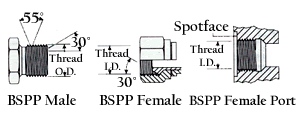ajoeiam
Well-Known Member
Greetings
I've cut outside (not fun but not terrible) and inside (not fun and almost a pita) NPT fittings.
The DIN fittings are quite non-standard here in North America.
Besides the fact that for a DIN38 I need to be able to cut 11 tpi (NOT 11.5 tpi like on some NPT) and that its a 55 degree included thread (our old friend Whitworth) rather than the 60 degree more common for most other things - - - what are the other gotchas.
I need to make a couple fittings termed as insert to DIN38 which means that one end is in a poly tubing and the other threads into my desired valve.
TIA
I've cut outside (not fun but not terrible) and inside (not fun and almost a pita) NPT fittings.
The DIN fittings are quite non-standard here in North America.
Besides the fact that for a DIN38 I need to be able to cut 11 tpi (NOT 11.5 tpi like on some NPT) and that its a 55 degree included thread (our old friend Whitworth) rather than the 60 degree more common for most other things - - - what are the other gotchas.
I need to make a couple fittings termed as insert to DIN38 which means that one end is in a poly tubing and the other threads into my desired valve.
TIA







